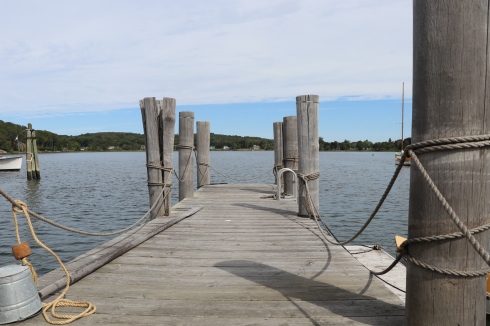
Date Of Visit: September 2, 2017
Location: 75 Greenmanville Ave. Mystic, CT
Hours: Open daily, 9:00 – 5:00 (hours may vary depending on the season)
Cost:
Adult – $28.95
Senior (ages 65+) – $26.95
Youth (ages 4-14) – $18.95
Children (3 and younger) – Free
Parking: there is a free parking lot across the street from the Seaport Museum. There is also additional parking across the street from the parking lot for overflow
Handicapped Accessible: Yes, but not all of the buildings are accessible to the handicapped. Approximately one-third of our buildings have wheelchair-accessible entrances; interior access varies. The village’s unpaved roads are generally firm and stable suitable for wheelchairs and strollers. All roads are basically level with a few slight inclines located near the Children’s Museum, Treworgy Planetarium and Membership Building. (see link below for more info)
Mystic Seaport Accessibility Guide
Dog Friendly: Yes, but they are not allowed in the buildings
Website: Mystic Seaport
Highlights: living museum with character actors, boats, replicas of historic homes, figureheads, lighthouse replica, play area for children
Tips:
- For an after museum viewing treat, Mystik Village, an open area shopping mall is a mere.9 miles away on Coogan Blvd
- the museum’s main parking lot can fill up quickly if you don’t get there early. Additional parking can be found in the lots off Rossie St on the other side of the main parking lot
In my previous posts about Mystic Seaport, I shown you the figureheads and the ships and boats of Mystic Seaport.
In this final installment, part three, I am going to focus on some of the buildings and historical items at the museum. I hope you enjoy!
The first exhibit room at the Thompson Exhibition Hall has many interactive exhibits and artifacts and exhibits from a bygone era.
The first interactive exhibit is called “Sea States.” At this exhibit, you can watch video of the water from calm
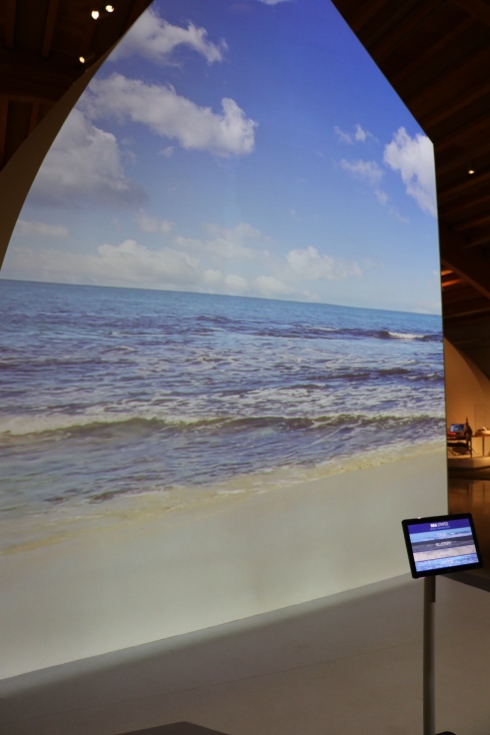
to blustery
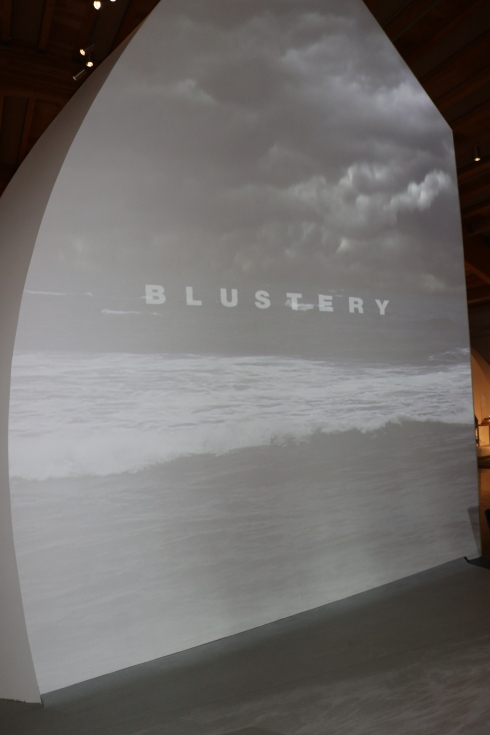
and every other weather condition you can think of.
In the Thompson Building is a very large room packed with lots of historical items. And many of these exhibits and items have interactive devices that give more information and historical context to the items.
These carved etchings were made on teeth and bones of whales.
People may think captains and other sailors were not attached to their families, being away from them for so long and because of traditional family dynamics. However, nothing could be further from the truth. Sailors seemed to have a very strong connection to their families, especially their children.
Pictured below are a glove box, photo of Captain Richard Columbus Mears and his Nellie, his daughter (Nellie Goodsell Mears Van Valkenburgh) and some wood carvings he made.
Captain Mears, born in Accomack County, Virginia in 1829, was a merchant ship captain based mainly out of New York.
The black and gold item on the left is a glove box that Captain Mears sent to Nellie for her 13th birthday. Believe it or not before plastics were invented people made these objects out of turtle shell. This particular glove box was made out of a hawksbill turtle shell.
The photo next to the glove box is a photo of Captain Mears with Nellie. To the right of the display are wood carvings by Captain Mears. The napkin ring, also carved by Captain Mears has the letters N E L L I E with a heart next to it.
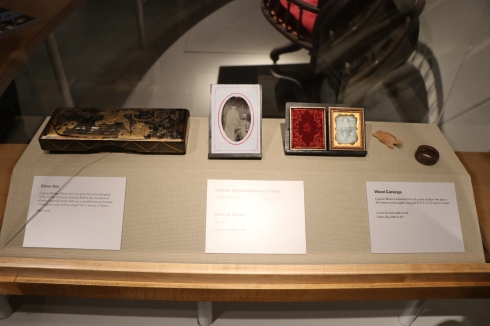
This crib also has turtle shell in its design. In the second photo you can see the turtle shell reflected in the mirror under the crib.
Most museums do not want you to touch their exhibits. But, the Seaport Museum has this replica of a turtle for people to touch to see what they felt like that. It was smooth and silky. I want one. A real one.
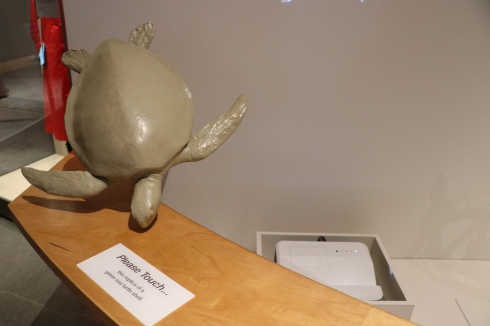
This bed from that era, pictured below, had some interesting designs on it.
These carvings are miniature figureheads. They are models of life sized figureheads that adorned ships of those days.
There are also several models of boats from the earlier days of the seaport.
Nikki McClure’s book To Market, To Market was on display at the Mallory Building. McClure, a papercut artist based out of Olympia, Washington, is an author and illustrator who mainly writes children’s books with an environmental theme. I love her art!
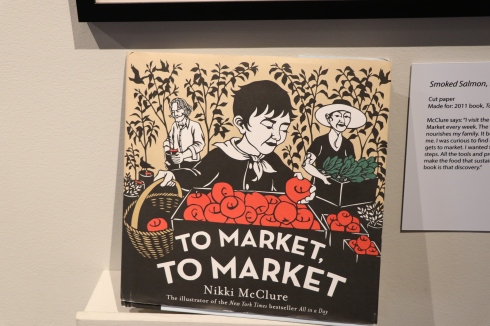
The were other works of art from her books Waiting For High Tide and Life In Balance.
I liked these pieces from her exhibit best.
I also loved the educational historical buildings with the re-enactors. The people in these buildings are very knowledgeable and friendly.
In this building, The Cooperage, coopers (barrel makers) were making barrels. The old fashioned way.
This is the Nautical Instruments Shop. They have many clocks and timepieces as well as nautical devices such as compasses in this building.
The Mystic Print Shop is a true to life replica of the print shops of the 1800’s. If you look closely at the photos in the corner, you will see how the template or blocks on the metal pad match up with the words on the printed sheets.
The people at the Shipsmith Shop and Hoop Shop reenact ship and mast builders.
There is also a replica of a lighthouse that you can enter. A short documentary plays on a loop in the lighthouse.
There are also several shops that are replicas of the buildings of the 1800’s.
The Geo. H. Stone & Co store is a replica of the stores of the time.
Of course no living history museum would be complete with a school house.
The drug store had some interesting remedies of the time.
The Seamen’s Friend Society was a place the seamen could go to read, learn to read or have a book read to them. Since sailors spent a lot of time at sea and began working at a very early age sometimes they were not literate. They came to places like to be tutored or just to have someone read to them.
Formerly located in Saybrook, Connecticut, the Buckingham-Hall House is a two story building with two bedrooms and several sitting and family rooms. Being self-sufficient people, there was also a sewing and quilting area with a variety of fibers. The house was owned by William Hall Jr., from the estate of Samuel Buckingham. I love how they used to design the windows in those days. They weren’t big as many windows are these days. But, they were much more fancy and, despite their small size, allowed for a good amount of light. There was also an open hearth cooking demonstration in the kitchen during my visit.
One of the other homes at the Seaport Museum is the Thomas Greenman House. The house was originally built for Thomas and Charlotte Greenman in 1942. THomas Greenman was originally from Westerly, Rhode Island but made his way to Mystic later in his life.
The kitchen and the second floor are not accessible to visitors. But the rooms on the first floor are decorated and furnished in the Victorian style of the 1870’s. I always think I want to live in these types of houses because of their ornate designs and their charm. Then I realize just how oppressive it must have been during the hot summers and frigid winters. Not to mention they didn’t even have WI-FI.
The Burrows House is a very small home, yet almost as big as my apartment, that stands as an example of many of the homes of that era. The house, which is said to have been built between 1805 and 1925, was the home of storekeeper Seth Winthrop Burrows and his milliner wife, Jane. That is some tight stairwell.
The Stillman Building has a variety of interactive displays and historical items collected over the years of the seaport’s history. My favorite part of their exhibits in this building are the notes children wrote about whales and the sea.
This timepiece, found by the children’s play area, acts like a sundial and gives precise times throughout the day. But, people seemed more interesting in using it for coat and backpack storage. I was tempted to check out that boat there.
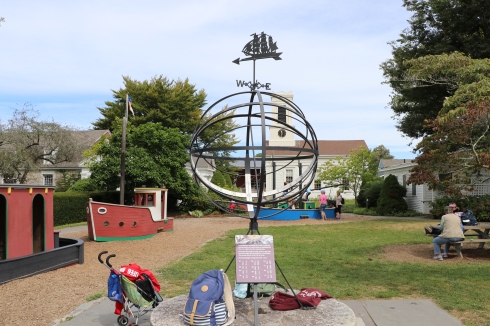
Lastly, the walkways to the different buildings is level and handicapped accessible (although some of the older historic buildings are not). And there are lots of pretty views along the way. I love the old pumper, which had to be moved manually.
Mystic Seaport is a dog friendly museum (although they are not allowed in the buildings). These two cute curly dogs were hanging out by the bench with their guardians.
Fuzzy (the white dog on on the left) is a 4 year old female Goldendoodle.
C-Doo (short for Colossus of Doodle), on the right, is a 1 year old Goldendoodle



























































































































































October 5th, 2017 at 11:01 pm
So cool! I love the little art exhibition from the children’s book, and the lighthouse and the drug store. The past is so fascinating! I would have loved to visit this enchanting place 😊😊. Thanks for the tour!
LikeLiked by 1 person
October 6th, 2017 at 12:32 am
Thank you, Trini! I love “living in the past” at these living museums as well. It’s just so interesting seeing how those people lived. I am glad you enjoyed the tour! ( :
LikeLike
October 6th, 2017 at 12:02 am
Enjoyed the tour! Thanks!^^
LikeLiked by 1 person
October 6th, 2017 at 12:32 am
Thank you, Sheryl!
LikeLiked by 1 person
October 7th, 2017 at 6:11 am
My great grandfather’s house was moved from downtown mystic ( near the bank) to the Seaport. My direct ancestor Thomas Minor was one of the founding father’s of Stonington……this post was dear to me in many ways, thank you! I did a year’s work at the Mystic Aquarium many ( many) years back, so the area really was a ‘stomping’ ground for me. So glad you did this post!!!
LikeLiked by 1 person
October 7th, 2017 at 8:11 pm
That is so cool! It is great that you have such a close connection to the area. Also, I’ve been to the aquarium and of course I saw the sea lions there. Such a fun place! I am glad it brought back some fun memories! ( :
LikeLiked by 1 person
October 7th, 2017 at 4:11 pm
Another good find. Mystic is fairly close to my grandparents home so I’ve been there but never to explore. Mostly to go clamming on the beach.
LikeLiked by 1 person
October 7th, 2017 at 8:03 pm
I love it out there. It is such a great area! If I had family out there, I would visit them every weekend, at least every weekend during the spring, summer and fall!
LikeLike